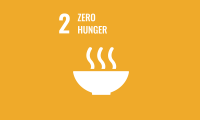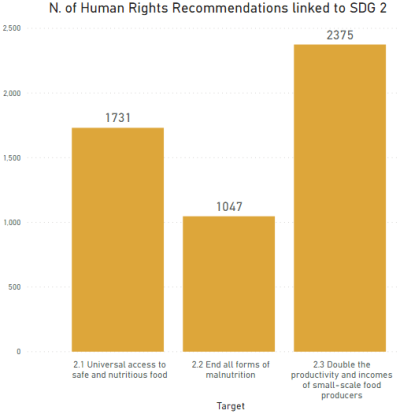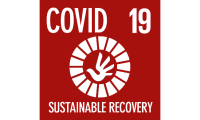SDG 2 and Sustainable Recovery

Key aspects of SDG 2:
1. End hunger and malnutrition (targets 2.1, 2.2)
Prior to the pandemic, the progress on the SDG 2 targets had stalled. The pandemic has caused further setbacks. The number of people facing hunger went up by an additional 118-161 million people in 2020 compared to 2019. Additionally, 2.37 billion people did not have access to adequate food in 2020 – an increase of 320 million in one year. The Ukraine crisis risks tipping up to 1.7 billion people — over one-fifth of humanity — into poverty, destitution and hunger.
The combined effects of isolation, lockdown, disruption of trade and agri-food value chains, and the suspension of income-generating activities is affecting food security of different populations. The gender gap has increased with moderate or severe food insecurity being 10% higher among women than men in 2020. For child wasting it has been estimated that the number might have increased by 15%, putting the lives of millions of children at risk. Regional differences are also extreme. More than half of the people affected by hunger in 2020 were in Asia and one-third in Africa.
Sustainable response and recovery actions:
Countries must tackle the pandemic and the hunger crisis following a human rights-based approach. This involves targeted programmes to ensure jobs, wages and benefits for all workers and nutrition-sensitive social protection programmes with special measures towards marginalized groups. This would lead to fewer people not having the funds to secure food for themselves and their families.
Visit the documents and resources listed in the “Key Human Rights Guidance” below for more information.
International Covenant on Economic, Social and Cultural Rights (ICESCR), art. 11.1: The States Parties to the present Covenant recognize the right of everyone to an adequate standard of living for himself and his family, including adequate food, clothing and housing […]
International Covenant on Economic, Social and Cultural Rights (ICESCR), art. 11.2: The States Parties to the present Covenant, recognizing the fundamental right of everyone to be free from hunger […]
United Nations Declaration on the Rights of Indigenous Peoples (UNDRIP), art. 20.1: Indigenous peoples have the right to maintain and develop their political, economic and social systems or institutions, to be secure in the enjoyment of their own means of subsistence and development, and to engage freely in all their traditional and other economic activities.
2. Increase productivity and incomes of small-scale food producers, ensure sustainable food production systems and proper, functioning food markets (targets 2.3, 2.4, 2.c)
The pandemic has affected the entire food system. Restrictions on movement within and between countrieshave hindered food-related logistics services, disrupted entire food supply chains and affected the availability of food.
Restrictions on movement has caused millions of seasonal workers to lose their livelihoods and posed challenges to food production, thus jeopardizing food security for all people, and especially people living in the poorest countries.
Regional cooperation and cross-border pest and disease monitoring and control activities have been impacted, potentially resulting in substantial losses in crop production. This poses an additional threat to food security.
Lockdown measures have impacted the ability of farmers, farm labourers, farm service providers, extension officers, input suppliers, processors and various other actors in the food system to perform their tasks. It has impacted markets and related services, including transport.
These disruptions translate into lower incomes for already vulnerable smallholder farmers, which then negatively affects their household food security. While some may experience temporary setbacks, the effects on more vulnerable smallholder farmers will be long-lasting.
Sustainable response and recovery actions:
It is essential that countries ensure that COVID-related measures do not disrupt the food supply chain. Food production, marketing and distribution must be declared essential services, humanitarian and nutritional assistance preserved, food security monitoring systems expanded, and relief must reach the most vulnerable.
Mitigation measures must be taken to prevent disruption of crop production and protection systems, and to support smallholder farmers in the short term. Such measures could include deferring credit payments, reducing interest on loans, and establishing price controls on essential inputs. In the medium and long-term the aims are to strengthen the resilience of local food systems to similar shocks, invest in agricultural research and development, and promote sustainable production and value chains.
Sustainable recovery also requires rethinking how we produce, process, market and consume food, and how we dispose of waste. This crisis can serve as a turning point to rebalance and transform food systems, making them more inclusive, sustainable and resilient.
International Covenant on Economic, Social and Cultural Rights (ICESCR), art. 11.2.: The States Parties to the present Covenant, recognizing the fundamental right of everyone to be free from hunger, shall take, individually and through international co-operation, the measures, including specific programmes, which are needed.
International Covenant on Economic, Social and Cultural Rights (ICESCR), 11.2.a: To improve methods of production, conservation and distribution of food by making full use of technical and scientific knowledge, by disseminating knowledge of the principles of nutrition and by developing or reforming agrarian systems in such a way as to achieve the most efficient development and utilization of natural resources.
Key Human Rights Guidance:
- Right to adequate food, International Covenant on Economic, Social and Cultural Rights (ICESCR), General Comment, No. 12 (E/C.12/1999/5), 1999
- The Impact of COVID-19 on Food Security and Nutrition, United Nations, Policy Brief, 2020
- Global Report on Food Crises, Global Network against Food Crises and Food Security Information Network (FSIN), Report, 2020
- COVID-19: Potential impact on the world’s poorest people. A WFP analysis of the economic and food security implications of the pandemic, World Food Programme (WFP), Report, 2020
- Food availability threats due to extreme weather and the COVID-19 crisis, Food and Agriculture Organization (FAO), Guidance, 2020
- Recommendations from human rights monitoring mechanisms linked to SDG 2 by country, Danish Institute for Human Rights, search page
- Human rights law and standards linked to SDG 2 by target, Danish Institute for Human Rights, search page


